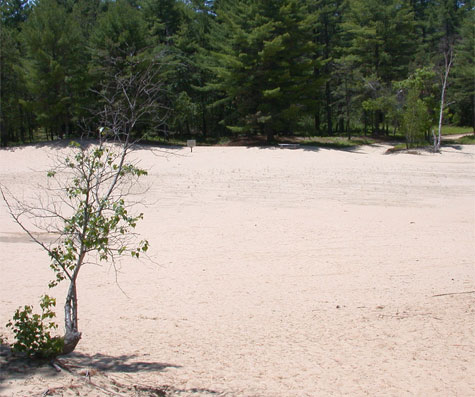
RUINED EARTH: Eroded into infertility, the Desert of Maine is being reclaimed by the forest. |
| Desert Of Maine | 95 Desert Rd, Freeport | daily 8:30 am-5:30 pm; tours on the half hour 9 am-4 pm | $8.75, ages 13-16 $6.25, ages 5-12 $5.25 | 207.865.6962 |
If you want to know what the future holds, take a ride up to the Desert of Maine in Freeport. It’s simultaneously an example of how badly we humans have been wrecking the Earth over the past few centuries, and a sign of hope that maybe the planet will recover after all.The desert, a Freeport “tourist destination” which has been featured in the New York Times and on the Discovery and Travel channels, can teach a few lessons about nature, but it is not quite the “natural” geological marvel that the marketing materials might suggest.
Fortunately, the video on the Web site gives us a couple hints: back in the 1700s, desert owner Gary Currens cheerfully explains, “it was actually productive farmland for several years, and then” — this is where the hints come — “between the clear-cutting, bringing sheep in, not rotating the crops proper [sic], sand all of a sudden started appearing.”
In the middle of explaining how all this sand, deposited by glaciers, began “appearing,” Gary, in the video (and a tour guide at the place itself), admits what you have started to suspect: “the topsoil was eroding.”
Yes, the “Desert of Maine,” the 50-acre swath of sand that would otherwise be forest, was “uncovered” by irresponsibly exploitative land-management practices that resulted in the erosion of thousands of years’ accumulation of topsoil in roughly a century, leaving behind a barren landscape that is, nevertheless, slowly being reclaimed by the forest around it.
The booklets, posters, and Web site call the sand — which once covered nearly 300 acres of former-farmland, and which may in places be as much as a mile deep — a “natural phenomenon,” but what’s most “natural” about this barren expanse in the middle of the Maine woods is that it’s Nature’s warning to any of us who might seek to exploit the land and its bounty. Without care, the blowing sands show us, we’ll lose everything and have to leave.
Wrecking the land
The story goes like this: a big huge glacier moved through Maine about 20,000 years ago, crushing stones beneath itself, leaving behind a sand-like silt with finer grains that you would encounter on an average Maine beach. Between the time the glacier retreated, leaving the sand on the surface, and the late 18th century, the land got relatively little use and was colonized by mosses and lichens, small plants, bushes, and eventually trees, as Maine’s forest expanded to cover most of the state. Roughly eight inches to a foot of fertile topsoil gradually accumulated in this area of the forest.
In 1797, the Tuttle family moved to the 300-acre parcel and raised potatoes, vegetables, hay, apples, and cattle. The family cut trees from the property to create fields and to sell as building lumber and firewood. As the trees departed, so did their root structures, which had played a major role in anchoring the top soil. The Tuttles next brought in sheep to raise for their wool. The sheep grazed very close to the ground, as sheep do, and pulled much of the grass out by the roots. To make matters worse, their hooves cut into the topsoil, loosening it up.
That is when the sand “started appearing,” and when things began to go wrong for the Tuttles. As one of the tour guides told it on a recent afternoon, the family cut down some of the last big trees on the property to use the branches to cover the sandy spots, in a vain effort to halt the erosion. You’ve spotted the rub, though: while they might have slowed erosion where they put the limbs, those last few trees were anchoring other topsoil, which soon sloughed away in spring thaws and summer rains. The sand took over completely.
After the Tuttles gave up and abandoned the place, a few opportunistic entrepreneurs got interested in this much-abused land. One bought it in hopes of selling the sand to brickmakers, but the silt was too fine and the bricks wouldn’t hold together. He, in turn, sold it to a man who wanted to make it a tourist attraction back in 1925, and so it has been ever since.
Preserving the sand
The sand, geologists now know, lies under the topsoil throughout much of Maine, New Hampshire, and even most of the northeastern United States — if it was covered by a glacier during the last ice age, there’s likely sand down there somewhere. (How deep the sand is, and how much topsoil has accumulated on top of it, varies widely.)